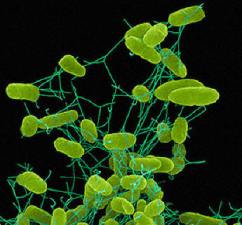Stress treatments show that Salmonella is a tough cookie

Salmonella is an important food born pathogen but its mechanisms to survive in the environment are still partly unclear. Speaking at the Western Poultry Disease Conference, Bart Weiner from the School of Veterinary Medicine, University of California presented new work on how Salmonella enteritidis survival can be reduced.
Salmonella have efficient mechanisms to survive processing and persist in the environment to cause gastrointestinal disease in humans. Salmonella are well document to survive acid, peroxide, osmotic and heat stress with many of the genes responsible for the survival well defined. In the recent work from Weiner and his colleagues they wanted to examine the way environmental stress influenced the survival rate of Salmonella and find novel ways – such as adding pre- and probiotics – to reduce the survival rate of this bacterium.
Cold and acid stress
The initial experiment examined the ability of Salmonella to survive cold stress for at least 336 hours to test the hypothesis that Salmonella can withstand long periods of exposure to low temperatures during the transition between animal hosts and the environment. It was shown that Salmonella survived cold stress for at least 336 hours. During the time course, survival declined after 48 hours, while at 5 degress Celcius a significantly high number of viable bacteria were observed after 240 hours. Exposure to peroxide, osmotoc and acid for 0.5 hours (shock) and 5 hours (stress) was examined to find that only peroxide shock significantly reduced survival.
Feed additives
Next to the stress treatments, the research team examined six prebiotic and five probiotic treatments. A dose response was observed with each prebiotic, but each treatment had an unique effect on Salmonella adhesion of stressed cells. For example, a certain MOS type encouraged adesion of Salmonella enteriditis beyond that of the control. Addition of probiotic lactic acid bacteria was tested to reduce adhesion. Bifidobacterium infantis was shown to have a beneficial effect on epithelial cells.
These new insights in the underlying mechanisms os stress resistance and host association will provide additional strategies to further reduce Salmonella viability to limit transmit in the environment and reduce infections and further outbreaks of Salmonella in the animal and human population. This research will be published as a full paper in the journal: Applied and Environmental Microbiology.
The Western Poultry Disease Conference was held for the 60th time and took place in Sacramento, California, from 20 till 23 March. For the full programme click here.












